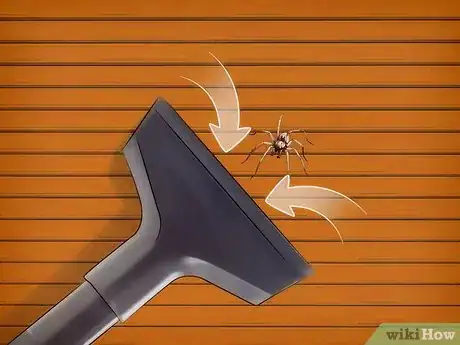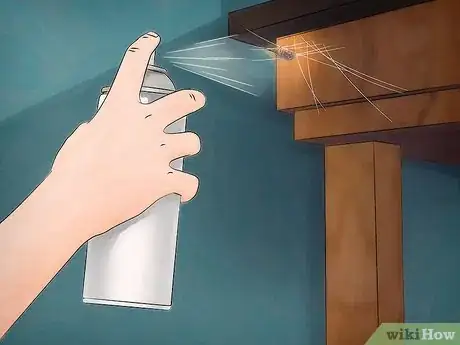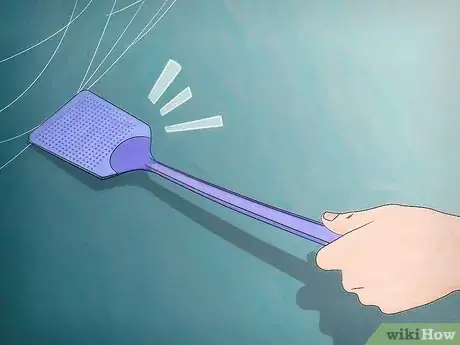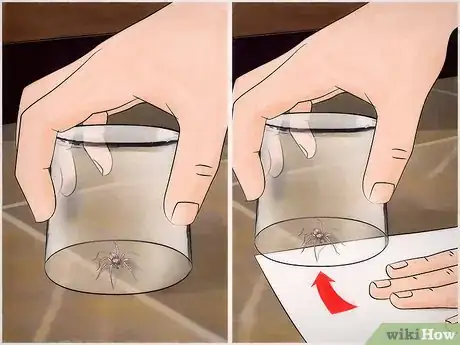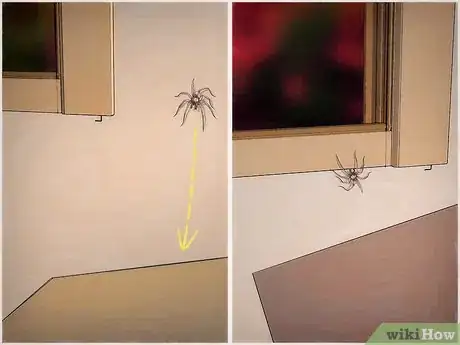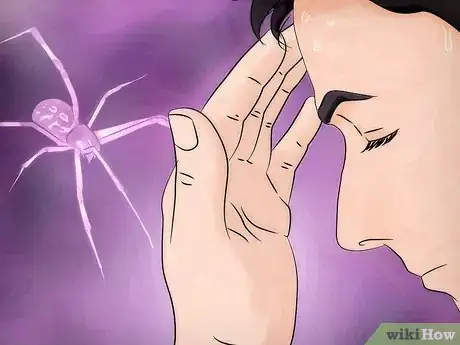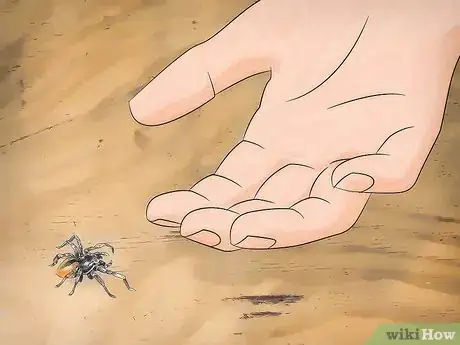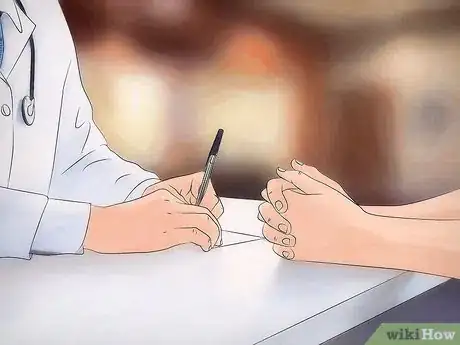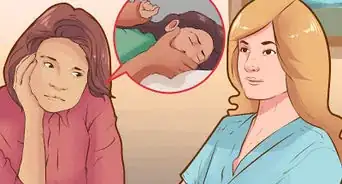This article was co-authored by William Gardner, PsyD. William Gardner, Psy.D. is a Clinical Psychologist in private practice located in San Francisco, CA’s financial district. With over 10 years of clinical experience, Dr. Gardner provides individually tailored psychotherapy for adults using cognitive behavioral techniques, to reduce symptoms and improve overall functioning. Dr. Gardner earned his PsyD from Stanford University in 2009, specializing in evidence-based practices. He then completed a post-doc fellowship at Kaiser Permanente.
There are 11 references cited in this article, which can be found at the bottom of the page.
This article has been viewed 201,874 times.
Arachnophobia is a common phobia, which affects approximately 50% of women and 18% of men.[1] Though scientists don’t really understand what causes phobias, many scientists believe phobias could be a learned behavior, related to a traumatic experience, or even a way to protect our species.[2] [3] If you have arachnophobia, and you come across a spider, your first instinct may be to run the other direction. In most cases, this may be enough, but if you have to deal with the spider (e.g. because it is in your home), then there are ways that you can kill the spider. However, because spiders play an important role in ecosystems, you may also want to consider trapping the spider and letting it go outside. You can also take steps to deal with your arachnophobia so that spiders won’t pose such a problem for you.
Steps
Killing the Spider
-
1Vacuum the spider up. One option for getting rid of the spider is to vacuum it up. If you have a bagless vacuum cleaner, take the spider in the vacuum’s tube, and dump it in an outside trash can. If you have a vacuum cleaner with a bag, throw the bag in an outdoor trash can.[4]
- It is important that you empty the vacuum cleaner. Don’t just put it back in the closet. If the spider survived being vacuumed up, it may simply crawl out the way it came in.
-
2Use bug spray. Another easy way to kill a spider from a distance is to spray the spider with bug spray. Many brands have created aerosol foams that can spray several feet. In most cases, spraying the spider with a bug spray will kill it, but even if it doesn’t for some reason, it will definitely slow the spider down a lot. Then you can easily squish it with something without having to worry that it is going to run at you.
- Be careful with bug sprays, though. Be sure to wash your hands thoroughly with soap and water after using the spray. Clean the area where you have sprayed thoroughly, especially if you have pets or young children that could come in contact with the residue left behind. Always store the spray in a safe place that cannot be reached by children or pets.
- Make sure to clean up the dead spider and throw it in the trash. This is especially important if you have pets that could come along and eat the dead spider. The bug spray could make your pet very sick, or it could even kill them.
Advertisement -
3Smash the spider. Perhaps one of the most common ways to kill a spider is to smash it. You can use whatever you have handy. A shoe, a phone book, a newspaper, or anything that you can bring down quickly and easily on top of the spider. A broom with a long handle can also work to smash the spider from a reasonable distance.
- Be careful, with this method of killing a spider you risk missing the spider or simply injuring it. If you smash it, make sure you smash it a few times until you are certain it is dead.
- Clean up the dead spider with a big wad of tissues.
-
4Freeze the spider. This may seem strange, but it turns out that this may be the most humane way to kill a spider. Catch the spider with a jar or other object that you can put a lid on. Place the spider in your freezer overnight. Since spiders experience cooling normally in the winter, it will not be unusual. The next day, you can fill the jar with alcohol, which will make sure the spider doesn’t come back to life after it thaws out. Flush the spider down the toilet.[5]
- You can catch the spider easily by placing the jar over the top of the spider. Slide something thin between the floor (or wall) and the top of the jar (a postcard works well). Flip the jar so that it is right side up, and take the lid in one hand. Pull the card off the top of the jar and quickly screw the lid on.
-
5Ask someone to do it for you. If you have arachnophobia, the most obvious way to get rid of the spider is to have someone else take care of it for you. If you see a spider, ask someone who lives with you if they can get rid of the spider for you.
- Go into another room while they are getting rid of the spider if it is making you feel like you are going to panic.
- You can even ask a neighbor to help you. This may be embarrassing, but if trying to deal with the spider on your own is unbearable, it’s a viable option.
-
6Consider leaving it alone. Although you may be afraid of them, spiders play an important role in ecosystems. They eat bugs that might otherwise infest your house. In general, they want you to leave them alone as much as you want them to leave you alone. If the spider isn’t bothering you, and you can function with it around, let it be.
- The spider will probably be looking for a way out of your house. This is because spiders actually don’t do well in houses. Spiders need lots of bugs to eat, and they prefer a moist environment. Consider leaving a window or door open, and the spider may find its own way out.[6]
Letting the Spider Go
-
1Leave the window/door open. Most spiders don’t do well in homes because they don’t have enough to eat and there is not enough moisture. If you have a door or window in the room that the spider is in, try leaving the door or window open for a while to see if the spider will find its own way out. If you can't stand to look at the spider, just leave the door/window open and leave the room for a few hours.
- By the time you come back, the spider will probably have found its way out.
-
2Catch the spider. This is probably the most common method of getting a spider out of your home without killing it. All you have to do is place something over the top of the spider. Slide a piece of thin cardboard between the lid and the floor (or wall) and then take the spider outside and let it go.[7]
- A big drinking glass works well.
- Make sure that the cardboard is not too flimsy. You want the cardboard to be strong enough that you can keep it pressed directly against the lip of the glass.
-
3Chase the spider outside. If the spider is already near an open window or door, you might be able to direct the spider out. If you are too afraid to get near it, try using something with a long handle (a broom works well) to gently nudge the spider in the direction of the door.[8]
- Do this subtly. If you are too aggressive you will probably scare the spider. This might make the spider run frantically (and if you’re unlucky, in the wrong direction — toward you!) to get away from the broom.
Dealing with Your Arachnophobia
-
1Understand what kind of arachnophobia you have. If you have arachnophobia, you likely fall into one of two categories: a monitor or a blunter. A monitor will search the environment (car, clothes, house, etc.) for a spider. When they find a spider, they will carefully monitor the movements of the spider to make sure it is not coming near them. A blunter, on the other hand, will do whatever they can to avoid seeing a spider. If they do see a spider, they will try to pretend that it is not there.[9]
- If you are a blunter, it will probably be more difficult for you to deal with the spider because you don’t even want to acknowledge that it is there.
- In some cases, a blunter may also be referred to as, “an avoider.”[10]
-
2Think about why you are afraid of spiders. What is it about spiders that leads to anxiety? Did you have a traumatic experience at some point in your life? Have you heard stories, or is it simply the way they look? Identifying what it is that scares you about a spider may help you to deal with that fear.[11]
- If you have a very strong phobia, you probably know that no amount of rationalization will help you overcome your fear.
- If you truly don't know where or why your fear originated, that is okay too. While it can provide some understanding, it isn't necessary in order to treat a phobia.
-
3Remind yourself that spiders are almost always harmless. There are very few spiders in the world that are actually aggressive, and most will only bite if they feel threatened. Although it may hurt a bit, even venomous spiders typically cannot inject enough venom to do any significant damage to a healthy human being. A spider will do its best to stay out of your sight if it can.[12]
- Many spiders aren’t even able to penetrate human skin.
- If you do get bit by a venomous spider clean the wound with mild soap and running water. Apply a cool compress to the affected area. If you feel any discomfort, you can take an over-the-counter pain medication.[13]
- In the United States, the two venomous spiders to watch out for are the black widow spider and the brown recluse. A black widow spider can be identified by the red hourglass marking on its underside. The brown recluse spider is brown and has a violin-shaped marking on its back. If you believe that you’ve been bitten by one, or are experiencing severe pain, stomach cramps, or an ulcer at the site of the bite, you should seek medical care.
-
4Learn about spiders. You may be able to overcome your fear of spiders by simply learning about spiders. Some of your fear may be related to things that you’ve heard that aren’t necessarily true. Taking time to learn about the fascinating lives of spiders may make you realize that they are not out to get you and, in fact, play an important role in ecosystems.
- For example, spiders play a very important role in controlling insect populations. Without spiders, we would likely face a shortage of food.[14]
- Spider venom may also be useful in treating medical conditions. Scientists are also learning about spider silk and how we might be able to use it for our own purposes. This is because spider silk is exceptionally strong.
-
5Seek professional help. If you feel that your arachnophobia is causing real problems in your life, you might want to consider seeking help from a mental health professional. With the right therapy, you may be able to overcome your phobia completely.[15]
- Therapists commonly use a process known as systematic desensitization to help people overcome their phobias by exposing them gradually to the thing that they are afraid of.
- It is also becoming more common to use virtual reality to help people overcome their phobias.
Expert Q&A
-
QuestionHow do you get rid of spiders with arachnophobia?
 William Gardner, PsyDWilliam Gardner, Psy.D. is a Clinical Psychologist in private practice located in San Francisco, CA’s financial district. With over 10 years of clinical experience, Dr. Gardner provides individually tailored psychotherapy for adults using cognitive behavioral techniques, to reduce symptoms and improve overall functioning. Dr. Gardner earned his PsyD from Stanford University in 2009, specializing in evidence-based practices. He then completed a post-doc fellowship at Kaiser Permanente.
William Gardner, PsyDWilliam Gardner, Psy.D. is a Clinical Psychologist in private practice located in San Francisco, CA’s financial district. With over 10 years of clinical experience, Dr. Gardner provides individually tailored psychotherapy for adults using cognitive behavioral techniques, to reduce symptoms and improve overall functioning. Dr. Gardner earned his PsyD from Stanford University in 2009, specializing in evidence-based practices. He then completed a post-doc fellowship at Kaiser Permanente.
Clinical Psychologist With all fears, the best way to deal with them is through exposure, so we can adapt to the stress. Gradual exposure therapy is usually the best way to deal with fears or phobias. You start with the knowledge that there's a picture of a spider in another room that makes you feel okay, and then you move on from there, until you can be in the same environment as those beings. Discuss this with a professional therapist so you can do it safely.
With all fears, the best way to deal with them is through exposure, so we can adapt to the stress. Gradual exposure therapy is usually the best way to deal with fears or phobias. You start with the knowledge that there's a picture of a spider in another room that makes you feel okay, and then you move on from there, until you can be in the same environment as those beings. Discuss this with a professional therapist so you can do it safely.
Warnings
- If you have been bitten by a spider and are having symptoms (e.g. stomach cramping, severe pain, or an ulcer where you were bitten), get medical assistance right away. Most spiders are not harmful, but it’s better to be safe than sorry.⧼thumbs_response⧽
Expert Interview

Thanks for reading our article! If you'd like to learn more about coping fears, check out our in-depth interview with William Gardner, PsyD.
References
- ↑ http://www.spring.org.uk/2013/11/scared-of-spiders-5-psychological-insights-into-arachnophobia.php
- ↑ https://www.mayoclinic.org/diseases-conditions/specific-phobias/symptoms-causes/syc-20355156
- ↑ http://www.spring.org.uk/2013/11/scared-of-spiders-5-psychological-insights-into-arachnophobia.php
- ↑ https://johnnysideburns.wordpress.com/2011/04/12/ten-ways-to-kill-a-spider/
- ↑ http://www.smithsonianmag.com/smart-news/if-you-must-kill-that-spider-the-best-way-is-to-freeze-it-88586004/?no-ist
- ↑ https://www.theguardian.com/lifeandstyle/2014/oct/14/do-something-challenge-conquering-arachnophobia-spiders
- ↑ http://www.mirror.co.uk/news/uk-news/five-best-ways-rid-giant-6295020
- ↑ http://www.mirror.co.uk/news/uk-news/five-best-ways-rid-giant-6295020
- ↑ http://www.mentalhealthy.co.uk/anxiety/phobias/arachnophobia.html
- ↑ https://explorable.com/e/arachnophobia
- ↑ https://explorable.com/e/arachnophobia
- ↑ http://www.mentalhealthy.co.uk/anxiety/phobias/arachnophobia-quick-facts.html
- ↑ http://www.mayoclinic.org/first-aid/first-aid-spider-bites/basics/art-20056618
- ↑ https://www.theguardian.com/environment/2014/aug/01/spiders-conservation-importance-agriculture
- ↑ http://www.mentalhealthy.co.uk/anxiety/phobias/arachnophobia.html
About This Article
If you need to kill a spider but you have arachnophobia, vacuum the spider up and throw the bag into your outdoor garbage can. This way, you don’t have to get close to the spider. Another easy way to get rid of a spider is by spraying it with bug spray. Even if the spray doesn’t kill the spider, it will definitely slow down enough that you can squish it with your shoe or a fly swatter. If you use bug spray, make sure to clean up the area with soap and water after you throw the spider away or else the residue can cause dogs and children to get sick. Alternatively, you can ask someone to kill the spider for you if your arachnophobia is really bad. It might feel embarrassing, but a lot of people are afraid of spiders, so they’ll probably understand. For more tips from our co-author, including how to get rid of a spider without killing it, read on.
